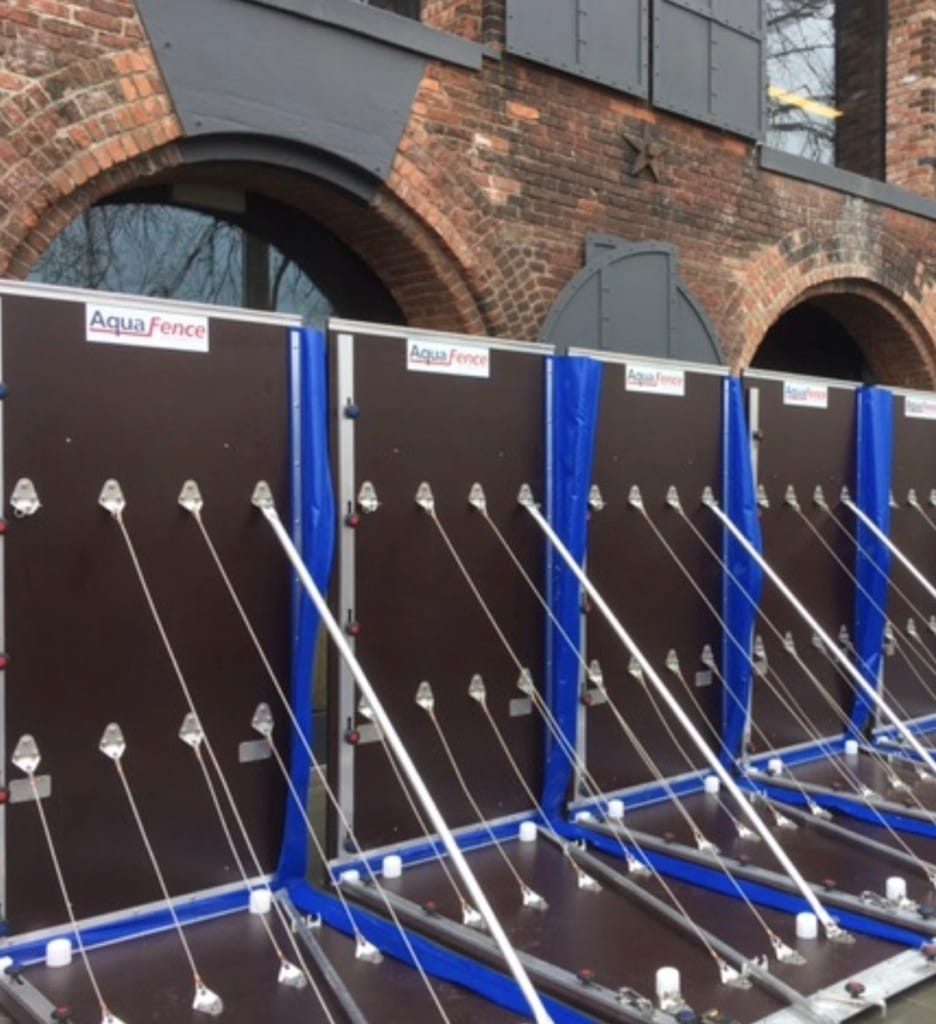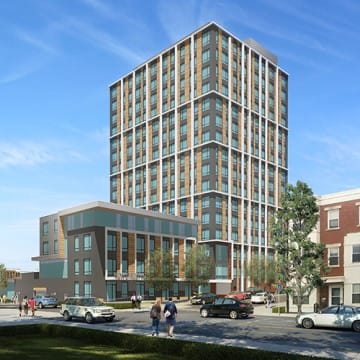Empire Stores
When Midtown Equities joined forces with HK to bid for the right to redevelop a 150-year-old coffee warehouse as a mixed-use, commercial, retail, and office complex in 2013, the site’s location 20 feet from the East River made it a jewel. But the memory of Superstorm Sandy, which had doused the shoreline and cloaked Lower Manhattan in darkness a year earlier, put the need to protect this jewel at the top of the developer’s list of challenges. Even as engineers calculated how to turn the 400,000 –square-foot raw space into a destination, the team reckoned with ways to separate the series of historic arched brick buildings from the same waterline that would attract visitors and tenants. They knew they needed to choose a protective strategy that they could test on dry days and that had prevailed in storms elsewhere.
The whole project hinged on the developers’ skill in connecting global placemaking wisdom to a historic slice of the Big Apple. The seven-building, Civil War-era complex known as Empire Stores came to bid as a byproduct of a city-state effort to redevelop 1.3 miles of former industrial waterfront in Brooklyn into Brooklyn Bridge Park, an 85-acre world-class, recreational, environmental, and cultural destination for New York City residents and visitors alike. The entity charged with the planning, design, and development of the park, the Brooklyn Bridge Park Development Corporation, operates and maintains the park. Its mandate to be financially self-sustaining spurred a limited number of revenue-generating development sites within the project’s footprint, one of which is Empire Stores.
Brooklyn Bridge Park emerged as a landlord, then, and as an asset. The success of Brooklyn Bridge Park capped 10 years of reinvention, both in the park along the waterfront and in the upland neighborhood of DUMBO behind it. That neighborhood’s former warehouses and rowhouses had morphed into luxury residential lofts, a commercial hub for technology startups and creative firms, and a thriving arts district that draws thousands of visitors each day. To lock in the neighborhood’s appeal, the government was bidding rights to redevelop the Empire Stores partly to help fund more attractions along Brooklyn Bridge Park.
A virtuous circle emerges between Empire Stores and the nearly complete Brooklyn Bridge Park. Today, this redesign of six former shipping piers attracts little children and their caregivers, basketball and volleyball teams, lunch-breakers and tourists who can gaze at the bridge to the north and the Statue of Liberty on the south. Empire Stores stands a few blocks north of the historic Fulton Ferry Landing pier, the location of the first ferry service between Brooklyn and Manhattan, that marks the main park entrance, fronting a lawn and walkway where couples often pose for wedding pictures.
The winning team quickly realized that a connection to the entire park, which was staying busy from sunrise yoga classes to sunset ferry riders, would also keep their site vital. Visitors to the park would wander over to the shops. Museum and office guests would snap selfies against the backdrop, spreading the site’s character across social media. And with a palette of grass and soil rather than concrete, the park can absorb stormwater before it reaches the site.
Plans evolved to fuse the park with the site. “We developed a program that would merge the whole ground floor with the park,” says architect Jay Valgora, whose firm Studio V worked on the building and landscape design. In 2013, the team told reporters that they planned a “Brooklyn marketplace.” Today, the ground floor features a mix of chain stores and restaurants, including a food hall whose vendors come approved by Time Out magazine- and national clothes retailer, J. Crew, which paid $140 per square foot for its space.
It also includes generous public space. The team cut an open courtyard, opening shutters onto the park and creating a path into a central stairway. It also focused that stairway on a public roof deck. For Midtown Equities chief Jack Cayre, the public space earns tenants’ affection and visitors’ admiration.
“When we were working on the project during the RFP process,” he says. “once we got to the roof, anybody from the most creative architect personality to an engineer just there to take measurements couldn’t help themselves but to stop, take out their iPhones, take pictures in every direction and really just take in the incredible vistas from that space.”
The Site’s Strengths
Cayre says he and his team knew all along that the waterfront made the site unique and hard to resist. The team also knew the public experience of the building would encourage people to cherish it, so members set out to make storm disturbances quick and forgettable. Cayre says he posed the following question: “Can we create something you can clean up after a storm with a mop, rather than something that requires us spend months tearing out Sheetrock?”
They learned, in investigating ways to boost the site’s resilience to storms, that its 150-year existence made many of its materials ready for anything.
When Cayre noted that Empire Stores’ original architects “never intended for people to live or work there,” and highlights an opening for creative strategies. In 2013, architects and engineers preserved and reinforced the stone walls and floors that had kept coffee beans ready for sale all those decades. These features also add a muted, natural patina that tech executives, furniture designers, and visitors and shoppers seem to prize.
The stone walls and floors that keep coffee beans from fermenting can also make returning to the office straightforward for 21st century professionals. “When Sandy came, the walls got wet,” Cayre says. “A week later, it was dry, and it was done.” This property led the team to think about a strategy that would protect tenants during almost any storm- and get them back to work within weeks of even the most cataclysmic storm.
They also had to form this strategy without recourse to elevating the structure. The waterfront location, historic-district requirements, and century-old buildings made lifting the structure onto a podium a nonstarter. Working with the site’s inherent materials and working through a series of models, the developers and their architects and engineers decided to make the place watertight while keeping its historic masonry facade and water views. They knew, though, that Sandy had sent seven-foot waves of water surging through the ground floor, knocking out columns there.
The site had comprised seven buildings “separated by massive stone walls,” recalls Valgora. He found a 19th Century painting in his research that heralded the stone-wall strategy as “Fortress Brooklyn.” In those days, the barricade kept the rowdy longshoremen away. To keep seven-foot waves from again knocking out the columns at grade, the team knew, the old shutters would also potentially fail. So, they decided to find a way to protect the building from a distance, as opposed to investing in on site strategies like elevating the building.
Good Fences, Good Resiliency
In choosing AquaFence, Cayre says, the team remembered that lenders had made the priorities clear. “The lenders’ first few questions were all about flood and how you are going to deal with it,” he said. “Flood insurance was definitely the focus of one of those questions. So that solution was put in place from the beginning. It had to be, before closing.”
The design and development team did this by procuring an AquaFence, a retractable flood wall that staff can store when the building doesn’t need it. The redesign also calls for placing on-site energy generation on the roof, behind an existing architectural feature.

Cayre and the team chose to use AquaFence partly because its technology had proved itself years before. The website for the Norwegian company that makes the flood barrier showcases deployments at office towers, factories, and a low-lying international airport.
“For us it was going to be this dam system that would keep the water away from the building,” says Cayre. “It was something that our construction and engineering people felt very strongly would give them the highest level of certainty in terms of it having a track record and being tested.”
Having agreed that it would cost way too much to try to repair the shutters, the development team appreciated the AquaFence’s simplicity. They test it twice a year for a day-and-a-half at a time, says Cayre. He sees training staff in its use as no more complicated than a fire drill.
Beyond the assurance these demonstrations provide, Cayre says the fence’s separation from the main structure kept costs and complexities from disrupting the project. Indeed, he describes the cost of installing, removing and storing the fence a “rounding error” and says existing staff can handle the testing and deployment without trouble.
The fence’s portable nature also helped keep construction on schedule. “Once we made the decision to do something not connected with the building, construction continued while were doing the research into the AquaFence,” Cayre says. He adds that the total project costs with the fence looked similar to early estimates.
Lenders endorsed the approach. The development team borrowed $280 million from AIG in 2013 for Empire Stores and $217 million for refinancing from M & T in late 2017.
The Hard Part: Restoring the Floor, Securing the Fence
Settling on the AquaFence as a protector set the team to engineering the site. That led to another challenge: restoring the water-worn floor.
As Valgora explains, 150 years of moisture and compaction had made the original packed-dirt floor into something less than a floor. So, before they could bulwark the site’s foundations from the waters that would soak it in a storm surge, the team actually had to create a foundation. “Originally, they were just timber soaked in creosote; There was no foundation. The only thing holding them up was 150 years of soil compression from holding hundreds of millions of tons of coffee beans, and that wasn’t going to work.”
Getting underneath the columns to create a new concrete floor kept the engineering team working overtime. They succeeded, though, in preserving the upstairs floors and walls. “The walls have the natural architectural character and beauty of the building,” Cayre says. “And if a flood did get in there [the walls] are not going to be damaged at all.” Higher up, the team installed an on-site generator. “There was space behind a historic facade where we were able to tuck in a generator on the fifth floor and not have it be visible from the outside,” says Cayre. (Rooftop mechanicals have become almost common in New York City after Sandy but would not fit the silhouette or mood that Empire Stores’ team had chosen.) This, he says, defines a backup strategy in the event that AquaFence or the pump system fails. “We think tenants would be up and running in weeks if not days.”
That backup plan, which experts call “redundancy,” defined a key benefit for tenants whose work lives flow over the Internet. Cayre says the backup generator can run “24/7,” provided a truck can deliver fuel to it. He also says that even after Sandy, trucks were able to travel on Water Street’s elevated grade.
Tenants, then, could potentially work through recovery from a disaster with no damage to anything permanent. “Business continuity came up with tenants who were touring the space,” says Cayre, “and we were able to very quickly put their concerns to rest.”
These include West Elm, which leased a third of the place and whose designers mock up new furniture in an office and whose retailers sell it on the ground floor. They also include Newell Brands, whose managers market smoke detectors, vacuum cleaners and other household staples. Brooklyn Historical Society even took space for a new gallery, showing confidence that their archived material would stay dry and accessible.
Today, Cayre says, the site draws people to the roof and from the park all day and has become a creative and community hub. “It’s really been as great as we could have hoped for,” he concludes. And he says he’s confident that three layers of security- the fence, the stone walls, and finally the generator- will keep it buzzing no matter what weather lies ahead.
Lessons Learned
If your main resilience challenge involves flood protection, you can invest in protections that don’t complicate your main building. By zeroing in on a dam-like strategy, Midtown and HK could satisfy lenders’ concerns about insurability and tenants’ concerns about business continuity without getting into the messy details of retooling a historic structure.
A new technology, if you can test it, can serve a historic site. The team hid its onsite generator to sustain their building’s historic character and keep the AquaFence tucked away. Other teams working in landmarked or distinctive areas may also choose resilience strategies that emphasize reliability over aesthetics or ingenuity.
Even in a world with superstorms, a site that engages the water’s edge can command a premium. Empire Stores opened years after Sandy, while news about climate change became more conclusive. Locals and tourists over the same span have made Brooklyn Bridge Park’s lowlands a New York City highlight. They pose for wedding pictures, schedule after-work parties, buy sofas and suits, and work long hours by the waterfront. The rolling edge and vista, and the convergence of old warehouse construction with new protections, make Empire Stores resilient to fads as well as storms.


